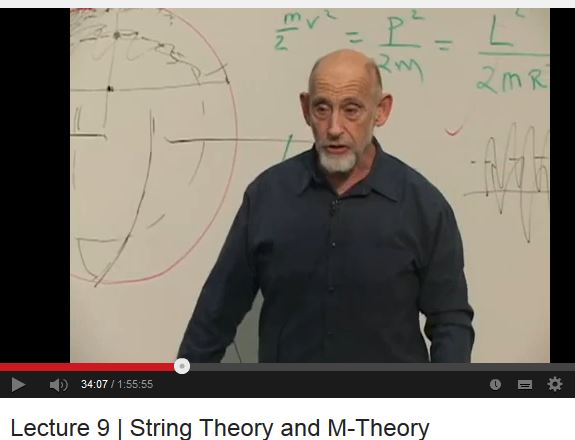Galu said:This news has made my muons go wobbly!
Muons: '''Strong''' evidence found for a new force of nature - BBC News
Fermilab accelerated muons around a 14 metre ring and, when subjected to a magnetic field, they wobbled at a rate faster than predicted by the Standard Model of physics.
There's a 4.1 sigma or 1 in 40,000 chance that the results provide evidence for the existence of an undiscovered sub-atomic particle or a new fundamental force!
With these Fermilab results following on from the LHC ones we discussed earlier, it would appear that particle physics research is really hotting up at the moment.
Have the experimenters found a new force of nature that makes the muons wobble faster than expected?
Could this be associated with a new sub-atomic particle such as the hypothetical leptoquark or the Z' boson?
Watch this space!
P.S. A muon is a fundamental particle similar to the electron, but with a mass 200 times greater. Muon - Wikipedia
Not more Forces of Nature, surely? 😕
I have enough trouble with the old ones.
But maybe three generations of W and Z Bosons. Second generation being W' or W Prime and Z' or Z Prime in current speculation.
Exciting times. 😎
Question is, why do these particles exist with such short lifetimes. Do they act as ‘enablers’ or are they transitory states between other, longer lived particles?
Professor Brian Cox has just been on the radio tasked with explaining the Fermilab results in layman's terms.
I'm not sure he totally succeeded, but here is some of what he had to say.
He started by explaining that space is not really empty, but is a sea of particles which continually wink in and out of existence.
Particle physicists use muons as very sensitive probes. As muons pass through space, they reveal anything unusual about the mix of temporary particles within it.
In the Fermilab experiment, there have been tiny departures from the normal behaviour of muons when passing through space, and that is what indicates the possibility that a hitherto undetected particle may exist.
I'm not sure he totally succeeded, but here is some of what he had to say.
He started by explaining that space is not really empty, but is a sea of particles which continually wink in and out of existence.
Particle physicists use muons as very sensitive probes. As muons pass through space, they reveal anything unusual about the mix of temporary particles within it.
In the Fermilab experiment, there have been tiny departures from the normal behaviour of muons when passing through space, and that is what indicates the possibility that a hitherto undetected particle may exist.
Severe technical troubles have afflicted Maison system7 tonight! I think my ancient Rotel RCD-965BX Special Edition CD player has conked out. Seems to have taken out the left channel of my stereo with a sharp loud crack too. Anyway, if I can't fix it, nobody can. I am an Engineer.
@Bonsai, energy transitions and lifetime depend on Fermi's Golden Rule:
Fermi's golden rule - Wikipedia
More energy and mass available means shorter lifetime. Simple as.
Back on-topic. I think we need Prof. Lenny Susskind here:

For those who don't know, String Theory came out of Hadron Physics. Which includes the currently interesting B-meson. Even as a mere Physics undergrad, I know second-generation particles violate CP conservation. Fermionic Leptons, neutrinos, quarks and maybe Bosons. I expect third generation ones do even odder things.
Why does the BBC always wheel out Prof. Brian Cox in these situations? Not that I don't enjoy his stuff.
@Bonsai, energy transitions and lifetime depend on Fermi's Golden Rule:
Fermi's golden rule - Wikipedia
More energy and mass available means shorter lifetime. Simple as.
Back on-topic. I think we need Prof. Lenny Susskind here:
For those who don't know, String Theory came out of Hadron Physics. Which includes the currently interesting B-meson. Even as a mere Physics undergrad, I know second-generation particles violate CP conservation. Fermionic Leptons, neutrinos, quarks and maybe Bosons. I expect third generation ones do even odder things.
Why does the BBC always wheel out Prof. Brian Cox in these situations? Not that I don't enjoy his stuff.
Attachments
Last edited:
Fermi's Golden rule appears to apply to energy level transitions in semiconductors and quantum optics. 😕Question is, why do these particles exist with such short lifetimes. Do they act as ‘enablers’ or are they transitory states between other, longer lived particles?
Here's something I have researched, not that it's likely to make us much wiser in the context of your question! 😉
A particle has a particular mass associated with it, it's just that it doesn't always have to have that mass.
When a particle has the right mass it is said to be "real", or "on mass-shell". If not, it is said to be "virtual", or "off mass-shell".
"Virtual" particles are unstable, living a very short time before decay. They are involved in the mathematical calculations of how "real" particles interact.
The "mass-shell" mathematics is explored here: Off mass-shell: Pythagoras to the LHC, via Einstein and Feynman | Science | The Guardian
Now I know that the mass of a particle is the "radius" of a shell in four-dimensional space-time.
Yippee! 😀
What I don’t get is that these particles popping in and out of existence have energy levels or require energy levels that are enormous. LHC or Fermi lab level stuff. If you’re sitting between two galaxies 3 million LY apart, where does this come from?
(I haven’t gotten to the particle physics bit in ‘Motion Mountain’ 🙂 )
(I haven’t gotten to the particle physics bit in ‘Motion Mountain’ 🙂 )
To push it a bit further (a bit of hereticism here) are these. It just mathematical artefacts ?
My good friends in the Physics thread will be pleased to hear that system7's stereo has recovered nicely. I was playing Andre Rieu's splendid Johann Strauss II Christmas CD record:

Suddenly it played double speed and I lost the left channel entirely! 😱

All is well now. I discovered jammy finger marks on the inner track. A software issue, not a Supernova explosion affecting things. 🙂
I think Fermi's rule applies to most things and very precisely. Still trying to understand this deeper than usual Galu article from "The Gniadrun" (famous for spelling mistakes...)
Off mass-shell: Pythagoras to the LHC, via Einstein and Feynman | Science | The Guardian
But if it is 4 dimensions, I am up for it. 😎
Suddenly it played double speed and I lost the left channel entirely! 😱
All is well now. I discovered jammy finger marks on the inner track. A software issue, not a Supernova explosion affecting things. 🙂
I think Fermi's rule applies to most things and very precisely. Still trying to understand this deeper than usual Galu article from "The Gniadrun" (famous for spelling mistakes...)
Off mass-shell: Pythagoras to the LHC, via Einstein and Feynman | Science | The Guardian
But if it is 4 dimensions, I am up for it. 😎
The mathematicians say that a signal should be found at a certain energy level and off go the experimentalists to locate it.It just mathematical artefacts ?
Does that signal represent a particle or just a resonance in a field?
Darned if I know! 😉
Resonance (particle physics - Wikipedia)
The Christmas gift that just keeps giving.I was playing Andre Rieu's splendid Johann Strauss II Christmas CD record

I couldn't wait to give my copy away! 😀
This is exactly what I've been wondering. I know it's hard to believe but I've been thinking this particle physics stuff is just mathematics we calculate into existence. I mean could it be an equation has a tangible artefact attached to it in the form of residual energy produced by mental thought? Arrival at the conclusion produces the particle, otherwise it does not yet exist?
The equation is the unit(s) of energy retrieved by the mind. How much energy would be commensurate to the bit(s) of information. Simple!
What is "eV"?

What is "eV"?
Last edited:
How much energy is in a thought?
Answers in eV please!
Answer to that probably somewhere in Motion Mountain!
How about this for a challenge: how much power in a thought (yes, a bit metaphysical/philosophical I know . . . )
Last edited:
I listen to a lot of classical Steve, so I’m with you there. Unfortunately, I draw the line at Andre Rieu 😀
The "eV", or electronvolt, is the unit of energy used in particle physics.What is "eV"?
One electronvolt is the amount of kinetic energy an electron gains when accelerated through a potential difference of one volt.
One electronvolt is equal to aproximately 1.6×10^−19 J.
The kinetic energy of a flying mosquito is roughly one trillion electronvolts!

Since mass and energy are equivalent, it is common to simply express the mass of a particle in terms of "eV".
Electronvolt - Wikipedia
P.S. You may have had difficulty in searching for a definition of eV, Pete.
When I asked my computer "What is an eV?" it came up with "What is an EV (Electric Vehicle)"! 🙁
When I asked my computer "What is an eV?" it came up with "What is an EV (Electric Vehicle)"! 🙁
A long time ago I was siiting having a card game with a florescent light fixture right above the table. I forgot the game now but it was a simple take a turn game requiring intuition. One of the tubes in the fixture was on it’s way out. The uncanny thing about it was that it would only flicker when the moment of recognition in both of us ocurred simultaneously as to the next upcoming interplay of the game. W’d look at each other, up at the light, and giggle. It happened every time through the whole game. Amazing.Answer to that probably somewhere in Motion Mountain!
How about this for a challenge: how much power in a thought (yes, a bit metaphysical/philosophical I know . . . )
I spent some time on Galu's two articles:
Muons: '''Strong''' evidence found for a new force of nature - BBC News
Anomalous muon precession in magnetic field? Standard Model in trouble again, that muon was involved in the anomalous B-Meson decay last fortnight too. Usual fix is to add another particle. 😀
Here's the one about this mass shell thing:
Off mass-shell: Pythagoras to the LHC, via Einstein and Feynman | Science | The Guardian
I did a back of a beermat calculation for a proton.
1.67 x 10^ -27 kg
c = 3 x 10^ 8 m/s
- E^2 / c ^2 = R^2 where R is this mass shell radius thingie
E/c = R which is 0.55 x 10^ -35 m
Doesn't make sense to me! The proton charge radius is conventionally 0.87 x 10^ -15 m. 😕
E/c has the dimensions of action divided by a length.
Muons: '''Strong''' evidence found for a new force of nature - BBC News
Anomalous muon precession in magnetic field? Standard Model in trouble again, that muon was involved in the anomalous B-Meson decay last fortnight too. Usual fix is to add another particle. 😀
Here's the one about this mass shell thing:
Off mass-shell: Pythagoras to the LHC, via Einstein and Feynman | Science | The Guardian
I did a back of a beermat calculation for a proton.
1.67 x 10^ -27 kg
c = 3 x 10^ 8 m/s
- E^2 / c ^2 = R^2 where R is this mass shell radius thingie
E/c = R which is 0.55 x 10^ -35 m
Doesn't make sense to me! The proton charge radius is conventionally 0.87 x 10^ -15 m. 😕
E/c has the dimensions of action divided by a length.
Last edited:
- Status
- Not open for further replies.
- Home
- Member Areas
- The Lounge
- What is the Universe expanding into..
